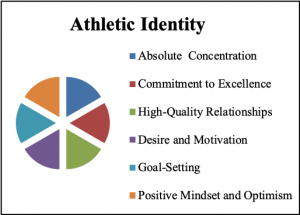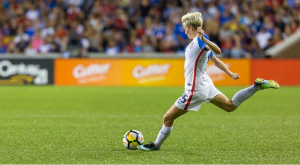By Lianna Malawski, Masters of Education Student, BU Wheelock, Counseling & Sport Psychology Program
Athletic Identity Foreclosure vs Athletic Identity
Who am I? When athletes answer this question, it is simple. I am an athlete. What makes you an athlete? This one is a bit more challenging. What makes us an athlete could be many things, it may be the time commitment that has been put towards the sport, their passion for the game, the determination and motivation to become better, the disciplined practice and skill, the list is endless. But what is an athlete’s answer to the question: “What comes next?”
In Brewer & Petitpas (2017), they identified athletic identity foreclosure as “individuals who fail to explore new life options and express commitment to the life role of an athlete” (p. 118). As an individual who fails to explore their life options during their athletic career, they end up limiting their options once they leave the sport. It is an interesting dynamic between an athlete’s foreclosure and their true identity. There is no rule book on how to live a specific lifestyle, so how are athlete’s meant to explore the future when focused on the now?
Ronkainen et al. (2020) described athletic identity as being particularly difficult when transitioning out of sport into the real world, even called it an “Achilles heel.” An athlete’s identity is not just a phase of life but a way of living. In the era of Coivd-19 where sport seasons have been cut short and in-person practices have all but been banished, fourth and fifth year athletes are now being asked to make this transition from sport earlier.
What to Expect From Our Bodies
As an athlete we expect a lot from our bodies. We expect them to last through intense trainings and lifts and bounce back after being iced, stretched and treated. When looking at research done by Hadiyan & Cosh (2019) on current and former elite athletes’ physical function, we can also see a patterned mindset in those athletes who have retired and moved on. In this study, all athletes’ bodies were put through seven physical and motor function tests. In the end there were no significant differences between both athletes’ physical fitness but showed a definite difference in motor function.
Part of the requirements for this study was to make sure the retired athletes had only been out of their sport for five years or less. As they are elite athletes it is not hard to assume that they have continued to put in effort to keep their musculature where it once was, but it is their new mindset and goals that have changed. Although they are not competitively competing, where is the line between healthy and problematic? Entering this new world is never easy, but with the help of healthy coping mechanisms, exploratory behavior and support the change can be done successfully.
A New World
Ronkainen et al. (2020) mentions the need for having a life plan in place to help restore an athlete’s lifeworld and harmony. Athletes should explore their aspirations while safely in their athletic identity; doing so will create a sustainable narrative for the future and provide assurance. Athletic retirement is not meant to be cut and dry; bodies do not automatically shift to the new normal and neither do our mindsets. With a detraining program that focuses on maintaining the new normal, a nutrition guide that explains healthy options when not under a rigorous schedule, and a way to prep them and their mindset for the outside world this can all be preemptive. Recreating this part in ourselves does not seem so crazy after all once the plan is put in place. Along with the help of a sport psychologist, using their natural athletic skill and transferring that into potential life skills is now achievable.
Ronkainen et al. (2020) guides us through the stages of an athlete’s psychological status after an alpine skier had a career ending knee injury. This athlete goes through many difficult obstacles in order to find her way in this strange new part of her life. As an athlete, the arena, pitch, court, field is your home. In this article we see Pilvi (the skier) face extremely hard decisions and plan a future for herself that she never thought she could reach and eventually come back and decide to take up a new sport. Asking the question, does our athletic identity ever come to an end?
In the face of adversity, athletes have the skill and determination to continue on, it is whether they choose to or not that is the deciding factor. A person’s exploratory behavior is what creates an identity; trying out new things, seeing what we like and dislike, enjoying new experiences, and deciding to continue on or switch to something new are decisions that all need to be made. This is where an athlete can get caught up in a time constraint. Once the sport has been picked and the mind has been set early on, it can prove to be extremely difficult to create a new identity when they have already formed one. It will always be a fight between an athlete’s foreclosure and their identity, but what comes next is always up to them.
References
Brewer, B. W., & Petitpas, A. J. (2017) Athletic Identity Foreclosure. Current Opinion in Psychology, 16, 118-122. http://dx.doi.org/10.1016/j.copsyc.2017.05.004
Hadiyan, H., Cosh, S. (2019). Level of Physical and Motor Fitness Post Retirement and Maintenance of Athletic Identity Within Active Retired Athletes. Journal of Loss & Trauma, 24(1), 84-95.
Ronkainen, N. J., Ryba, T. V., & Allen-Collinson, J. (2020). Restoring Harmony in the Lifeworld? Identity, Learning, and Leaving Preelite Sport, The Sport Psychologist, 1-8. Retrieved Nov 14, 2020, from https://journals.humankinetics.com/view/journals/tsp/aop/article-10.1123-tsp.2020-0009/article-10.1123-tsp.2020-0009.xml
Schaffeld, C. (2020). Megan Rapinoe was one of several players on the U.S. Women’s National Team who spoke out against a legal filing in a gender pay lawsuit against the U.S. Soccer Federation. [Photograph]. Bizwomen. https://www.bizjournals.com/bizwomen/news/latest-news/2020/03/women-soccer-players-protest-unacceptable-filing.html?page=all

